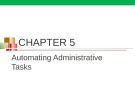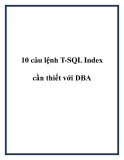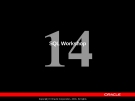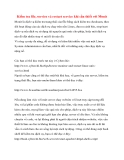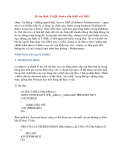
Sql administrator
-
In the knowledge byte section, tell the students about how to use the copy database wizard to copy or move databases and related objects to a different database server or another SQL Server instance. When using the copy database wizard you must have database administrator permissions on both the source and destination servers. Also, ensure that the second instance of SQL Server is installed, with the name SERVER\SECOND.
 46p
46p  anhgau456
anhgau456
 25-11-2015
25-11-2015
 42
42
 3
3
 Download
Download
-
Bài giảng Cơ sở dữ liệu nâng cao - Chapter 5: Automating administrative tasks. Những nội dung chính được trình bày trong chương này gồm có: Automating administrative tasks in SQL server, SQL server agent, creating maintenance plans.
 19p
19p  nomoney10
nomoney10
 05-04-2017
05-04-2017
 81
81
 7
7
 Download
Download
-
10 câu lệnh T-SQL Index cần thiết với DBA .Những người SQL Server DBA (Database Administrator) – quản trị cơ sở dữ liệu biết rất rõ rằng các danh mục Index trong database rất giống với Index trong mục Library. Hoặc hiểu theo cách đơn giản rằng Index trong Database là 1 hệ cấu trúc có liên kết chặt chẽ với các bảng để nhanh chóng thu thập thông tin từ các dòng trong bảng đó.
 12p
12p  badaovl
badaovl
 18-05-2013
18-05-2013
 104
104
 7
7
 Download
Download
-
This workshop covers: Creating tables and sequences Modifying data in the tables Modifying table definitions Creating views Writing scripts containing SQL and iSQL*Plus commands Generating a simple report
 14p
14p  trinh02
trinh02
 28-01-2013
28-01-2013
 74
74
 4
4
 Download
Download
-
Built-In Database Objects In addition to creating the database files, several other structures are created. Data dictionary: Contains descriptions of the objects in the database Dynamic performance tables: Contains information used by the database administrator (DBA) to monitor and tune the database and instance PL/SQL packages: Program units adding functionality to the database. These packages are created when the catproc.sql script is run after the CREATE DATABASE command. PL/SQL packages will not be discussed within the scope of this course.
 20p
20p  trinh02
trinh02
 28-01-2013
28-01-2013
 66
66
 4
4
 Download
Download
-
In either case, the easiest way is to drop the entire tablespace that contains the datafile. The steps that are to be executed from within SQL*Plus are: 1. STARTUP MOUNT 2. For each deleted datafile, issue the command ALTER DATABASE DATAFILE ’full path of filename’ OFFLINE [DROP]; Note: You must use the DROP option if the database is in NOARCHIVELOG mode, because you cannot recover this file if you apply incomplete media recovery on it via the command ALTER DATABASE OPEN RESETLOGS. See the SQL Reference for details. 3. ALTER DATABASE OPEN; 4.
 14p
14p  trinh02
trinh02
 28-01-2013
28-01-2013
 54
54
 4
4
 Download
Download
-
Trong bài này chúng ta sẽ tìm hiểu một chút lý thuyết về backup và restore database trong SQL Server. Chiến Lược Phục Hồi Dữ Liệu (Data Restoration Strategy) Có một điều mà chúng ta phải chú ý là hầu như bất kỳ database nào cũng cần được phục hồi vào một lúc nào đó trong suốt chu kỳ sống của nó. Là một người Database Administrator bạn cần phải giảm tối đa số lần phải phục hồi dữ liệu, luôn theo dõi, kiểm tra thường xuyên để phát hiện các trục trặc trước khi nó xảy ra. Phải dự...
 20p
20p  suthebeo
suthebeo
 17-07-2012
17-07-2012
 252
252
 46
46
 Download
Download
-
Monit là dịch vụ kiểm tra trạng thái của file bằng cách kiểm tra checksum, theo dõi hoạt động của các dịch vụ chạy trên nền Linux, đưa ra cảnh báo, stop/start dịch vụ nếu dịch vụ sử dụng tài nguyên quá mức cho phép, hoặc một dịch vụ nào đó đột nhiên stop vì một lí do nào đó. Vì công cụ này đa năng, dễ sử dụng và kiêm khá nhiều việc mà một Linux System Administrator cần làm, nhất là đối với những máy chủ chạy dịch vụ nặng nề....
 7p
7p  abcdef_43
abcdef_43
 03-11-2011
03-11-2011
 78
78
 4
4
 Download
Download
-
Quản Trị Mạng - Những người SQL Server DBA (Database Administrator) – quản trị cơ sở dữ liệu biết rất rõ rằng các danh mục Index trong database rất giống với Index trong mục Library. Hoặc hiểu theo cách đơn giản rằng Index trong Database là 1 hệ cấu trúc có liên kết chặt chẽ với các bảng để nhanh chóng thu thập thông tin từ các dòng trong bảng đó. Trong bài viết dưới đây, chúng tôi sẽ giới thiệu với các bạn những câu lệnh về T-SQL có liên quan tới Index trong SQL rất có ích đối...
 7p
7p  abcdef_43
abcdef_43
 03-11-2011
03-11-2011
 134
134
 14
14
 Download
Download
-
Lỗi này cực kỳ nguy hiểm, bởi vì có rất nhiều site shopping sử dụng phần mềm VP-ASP! Nếu 1 site bị lỗi này, hacker có thể: +Nhìn thấy đường dẫn database/configuration +Thay đổi đương dẫn của file database/configuration +Download file database/configuration +Đặc biệt: Login như administrator của (phần mềm) VP-ASP trên site đó, hoặc login với quyền admin vào host của site đó ( nếu chúng bị thêm lỗi SQL injection ) với user và pw đều là 'or''=' .......
 2p
2p  vn9h_vnc
vn9h_vnc
 26-04-2011
26-04-2011
 176
176
 24
24
 Download
Download
-
Backup and Restore a DataBase Trong bài này chúng ta sẽ tìm hiểu một chút lý thuyết về backup và restore database trong SQL Server. Chiến Lược Phục Hồi Dữ Liệu (Data Restoration Strategy) Có một điều mà chúng ta phải chú ý là hầu như bất kỳ database nào cũng cần được phục hồi vào một lúc nào đó trong suốt chu kỳ sống của nó. Là một người Database Administrator bạn cần phải giảm tối đa số lần phải phục hồi dữ liệu, luôn theo dõi, kiểm tra thường xuyên để phát hiện các trục trặc trước khi nó...
 5p
5p  camry1357
camry1357
 25-12-2010
25-12-2010
 155
155
 30
30
 Download
Download
-
The Best Damn Windows Server 2003 Book Period- P87:The latest incarnation of Microsoft’s server product,Windows Server 2003, brings many new features and improvements that make the network administrator’s job easier.This chapter will briefly summarize what’s new in 2003 and introduce you to the four members of the Windows Server 2003 family: the Web Edition, the Standard Edition, the Enterprise Edition, and the Datacenter Edition.
 10p
10p  davidvilla2468
davidvilla2468
 02-11-2010
02-11-2010
 60
60
 4
4
 Download
Download
-
The Best Damn Windows Server 2003 Book Period- P81:The latest incarnation of Microsoft’s server product,Windows Server 2003, brings many new features and improvements that make the network administrator’s job easier.This chapter will briefly summarize what’s new in 2003 and introduce you to the four members of the Windows Server 2003 family: the Web Edition, the Standard Edition, the Enterprise Edition, and the Datacenter Edition.
 10p
10p  davidvilla2468
davidvilla2468
 02-11-2010
02-11-2010
 48
48
 3
3
 Download
Download
-
The Best Damn Windows Server 2003 Book Period- P80:The latest incarnation of Microsoft’s server product,Windows Server 2003, brings many new features and improvements that make the network administrator’s job easier.This chapter will briefly summarize what’s new in 2003 and introduce you to the four members of the Windows Server 2003 family: the Web Edition, the Standard Edition, the Enterprise Edition, and the Datacenter Edition.
 10p
10p  davidvilla2468
davidvilla2468
 02-11-2010
02-11-2010
 44
44
 3
3
 Download
Download
-
The Best Damn Windows Server 2003 Book Period- P79:The latest incarnation of Microsoft’s server product,Windows Server 2003, brings many new features and improvements that make the network administrator’s job easier.This chapter will briefly summarize what’s new in 2003 and introduce you to the four members of the Windows Server 2003 family: the Web Edition, the Standard Edition, the Enterprise Edition, and the Datacenter Edition.
 10p
10p  davidvilla2468
davidvilla2468
 02-11-2010
02-11-2010
 32
32
 2
2
 Download
Download
-
The Best Damn Windows Server 2003 Book Period- P75:The latest incarnation of Microsoft’s server product,Windows Server 2003, brings many new features and improvements that make the network administrator’s job easier.This chapter will briefly summarize what’s new in 2003 and introduce you to the four members of the Windows Server 2003 family: the Web Edition, the Standard Edition, the Enterprise Edition, and the Datacenter Edition.
 10p
10p  davidvilla2468
davidvilla2468
 02-11-2010
02-11-2010
 40
40
 2
2
 Download
Download
-
The Best Damn Windows Server 2003 Book Period- P74:The latest incarnation of Microsoft’s server product,Windows Server 2003, brings many new features and improvements that make the network administrator’s job easier.This chapter will briefly summarize what’s new in 2003 and introduce you to the four members of the Windows Server 2003 family: the Web Edition, the Standard Edition, the Enterprise Edition, and the Datacenter Edition.
 10p
10p  davidvilla2468
davidvilla2468
 02-11-2010
02-11-2010
 37
37
 2
2
 Download
Download
-
The Best Damn Windows Server 2003 Book Period- P71:The latest incarnation of Microsoft’s server product,Windows Server 2003, brings many new features and improvements that make the network administrator’s job easier.This chapter will briefly summarize what’s new in 2003 and introduce you to the four members of the Windows Server 2003 family: the Web Edition, the Standard Edition, the Enterprise Edition, and the Datacenter Edition.
 10p
10p  davidvilla2468
davidvilla2468
 02-11-2010
02-11-2010
 28
28
 2
2
 Download
Download
-
The Best Damn Windows Server 2003 Book Period- P70:The latest incarnation of Microsoft’s server product,Windows Server 2003, brings many new features and improvements that make the network administrator’s job easier.This chapter will briefly summarize what’s new in 2003 and introduce you to the four members of the Windows Server 2003 family: the Web Edition, the Standard Edition, the Enterprise Edition, and the Datacenter Edition.
 10p
10p  davidvilla2468
davidvilla2468
 02-11-2010
02-11-2010
 35
35
 2
2
 Download
Download
-
The Best Damn Windows Server 2003 Book Period- P69:The latest incarnation of Microsoft’s server product,Windows Server 2003, brings many new features and improvements that make the network administrator’s job easier.This chapter will briefly summarize what’s new in 2003 and introduce you to the four members of the Windows Server 2003 family: the Web Edition, the Standard Edition, the Enterprise Edition, and the Datacenter Edition.
 10p
10p  davidvilla2468
davidvilla2468
 02-11-2010
02-11-2010
 39
39
 2
2
 Download
Download
CHỦ ĐỀ BẠN MUỐN TÌM









